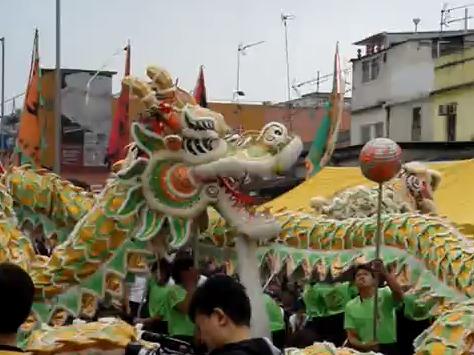Chinese Dragon Dance

The art of dragon dance originated from China (180 – 230 AD) during the Han dynasty. The dragon is made up by a team who holds or carries the poles connected to the image of the dragon.
According to Hakka tradition, the dragon should not be seen by the public before its eyes have been dotted. It is considered wild dragon and can perform in festivals but the dragon cannot enter temples or receive ‘ang pao’ (red envelopes) from the public until the dragon’s eyes have been dotted or literally the irises of its eyes painted. The dragon’s eye dotting ceremony is the ceremony where the spirit of the dragon is being brought down from heaven into the dragon dance apparatus.
Dragon's Eye Dotting Ceremony
 The eye dotting ceremony is usually performed by a Taoist/Buddhist Monk, so as a prayer is inscribed on the parts of the dragon’s body. After the ceremony, the dragon is given life. The eye dotting ceremony is held seven days before the lantern festival. The team of the dancers kneel on their right knees while holding tthe poles of the dragon with thier right hands in order to welcome the deity.
The eye dotting ceremony is usually performed by a Taoist/Buddhist Monk, so as a prayer is inscribed on the parts of the dragon’s body. After the ceremony, the dragon is given life. The eye dotting ceremony is held seven days before the lantern festival. The team of the dancers kneel on their right knees while holding tthe poles of the dragon with thier right hands in order to welcome the deity.
During the ritual, a mixture of rice wine (which symbolizes birth and helps the movement of qi), cinnabar (a burnt red ore of mercury that is said to be holy and eliminates evl influences) and blood from a white rooster’s cockscomb (white symbolizes purity, rooster symbolizes power, cockscomb symbolizes supremacy and the blood of a cockscomb is a symbol of supreme life) are applied with a new ink brush to the head, body and tail of the dragon.
When applying the dots, special words that capture the symbolism of each dot as well as its position on the body are spoken. Let’s take 15 sections-long dragon for an example;
Facing the dragon’s head, the dotter will dot the dragon to gather blessings; the dragon’s right eye will be dotted frst to bring light to the eyes. After that, the left eye is also dotted to view the distance. Third, the dragon’s right ear will be dotted to hear the wind and then the left ear will also be dotted to hear the distance.
Next, the nose is dotted to smell everything. The mouth is dotted to drink sweet dew from the universe and the forehead is dotted for the heaven. After that, 14 dots will be placed along the dragon’s body starting up by the head and finishing at the tail. These dots symbolize sun, earth, moon, stars, rain, wind, lightning, thunder, fire, water, mountains, ocean, rivers and finally at the tail, wealthy and happy nation.
A red cloth with golden flowers symbolizing good fortune and joy is then hung on the horns of the dragon. After the ceremony, this dragon is ready for visitors and the dance team will dance to the beat of drums and gongs. After the dragon’s eyes are dotted, usually there will be many worshippers worship the dragon every morning and evening until the Lantern festival.
Longest Dragon Dance
According to Guinness World Records, the longest dancing dragon was 5,056 m long (over 2 km longer than the previous record). The dragon was supported by over 1,000 people with poles. It was manufactured according to old Chinese traditions for the opening ceremony of 25th Luoyang Peony Festival of Henan Province, China on April 2007.
Copyright © 2009 Game Frog
Home | Contact | Disclaimer | Privacy Policy